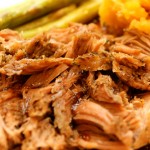All my life, my idea of the perfect weekend brunch plate has actually been Paleo-friendly – eggs benedict topped with spinach, smoked salmon and hollandaise. I never cared for the bagel, bread or whatever they put on the bottom anyway. Hollandaise has been surprisingly hard to come by in American restaurants I’ve gone to where it could be found in every little New Zealand cafe. To get around this I decided to try my own version of Julia Child’s Hollandaise Sauce.
When I started reading Julia Child’s chapter on Hollandaise, I was surprised to find only a handful of ingredients. It seemed unreal that such a wonderful sauce could be made from simple ingredients.
Julia went into detail about how delicate and precise the process was for preparing hollandaise. She did provide a foolproof recipe that involved a blender but was quick to add that every good cook should learn how to prepare this by hand (in other words, the blender method is for wusses).
She mentioned that the process should only take 5 minutes but I was very cautious and it ended up taking a good 40 minutes because I took care to very slowly find that sweet spot for temperature setting on my stove with my particular saucepan and also to very slowly add the first drops of butter to the yolks. If I made this again, I believe it would take 5-10 minutes. I strongly encourage you not to rush it when you do this for the first time so that you don’t risk ruining it.
First was the easy step of melting the butter in a small saucepan. As a side note, I found the Central Market organic butter to look more yellow than the Whole Foods organic brand. From what I read, the yellow is a sign of high beta-carotene indicating happy, free-roaming cows that eat lots of nice grass instead of grain-fed sad cows.
Next, we whisk the yolks and seasoning over very slow heat to create a creamy mixture ready to have butter added. It is very important at this step not to get a lumpy mixture so heat control is key. Take it really easy and watch your mixture closely.
Then, comes the process of slowly adding the melted butter to the yolk mixture while furiously whipping away. Start with little droplets of butter until your mixture is nice and thick before adding more butter at a time.
Once all the butter is added, you can correct seasoning and enrich this sauce by stirring in herbs like parsley or tarragon for added flavor. You should end up with a rich, yellow, creamy sauce ready to use on eggs, fish or vegetables. Keep it in a tepid water bath to keep it warm while you prepare other dishes.
Julia Child’s Hollandaise Sauce Ingredients:
- A small saucepan
- A medium-weight 4-6 cup saucepan
- A wire whip
- 3/4 to 1 cup of butter
- 3 egg yolks
- 1 TBSP cold water
- 1 TBSP lemon juice
- 2 TBSP cold butter, divided
- Big pinch of Sea Salt
Julia Child’s Hollandaise Sauce Directions:
- Cut the 1 cup of butter into small pieces and melt in the small saucepan over moderate heat. Set aside
- In the medium saucepan, beat the egg yolks for 1 minute until they become thick and sticky
- Add water, lemon juice and pinch of sea salt and beat for half a minute more
- Add 1 TBSP cold butter but do not beat it in.
- Place the saucepan over very low heat or barely simmering water and stir the egg yolks with a wire whip until they slowly thicken into a smooth cream. If you notice it is thickening too quickly or start to look lumpy, immediately remove the pan from heat and set in a bowl of cold water to cool the pan, beating the eggs to cool them. Then continue beating over heat.
- The egg yolks have thickened enough when you can begin to see the bottom of the pan between strokes and the mixture forms a light cream on the wires of the whip.
- Immediately remove from heat and beat in the remaining 1 TBSP of cold butter to cool the yolks and stop their cooking
- While beating with the wire whip, pour the melted butter by droplets until the sauce begins to thicken into a very heavy cream
- Then you can start pouring the butter a little more rapidly (leave the milky residue at the bottom of the butter pan)
- Taste the final sauce and you can correct seasoning if you wish with more salt, white pepper and lemon juice. I also added some chopped parsley at this point
- To keep warm for serving, set your saucepan in a tepid water bath. Just before serving, you can whisk in a little bit of soft butter
I served my hollandaise over some pan-fried tilapia fillets (post to follow).
Bon Apetit!










